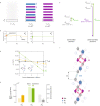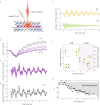Interlayer magnetophononic coupling in MnBi2Te4
- PMID: 35396393
- PMCID: PMC8993894
- DOI: 10.1038/s41467-022-29545-5
Interlayer magnetophononic coupling in MnBi2Te4
Abstract
The emergence of magnetism in quantum materials creates a platform to realize spin-based applications in spintronics, magnetic memory, and quantum information science. A key to unlocking new functionalities in these materials is the discovery of tunable coupling between spins and other microscopic degrees of freedom. We present evidence for interlayer magnetophononic coupling in the layered magnetic topological insulator MnBi2Te4. Employing magneto-Raman spectroscopy, we observe anomalies in phonon scattering intensities across magnetic field-driven phase transitions, despite the absence of discernible static structural changes. This behavior is a consequence of a magnetophononic wave-mixing process that allows for the excitation of zone-boundary phonons that are otherwise 'forbidden' by momentum conservation. Our microscopic model based on density functional theory calculations reveals that this phenomenon can be attributed to phonons modulating the interlayer exchange coupling. Moreover, signatures of magnetophononic coupling are also observed in the time domain through the ultrafast excitation and detection of coherent phonons across magnetic transitions. In light of the intimate connection between magnetism and topology in MnBi2Te4, the magnetophononic coupling represents an important step towards coherent on-demand manipulation of magnetic topological phases.
© 2022. The Author(s).
Conflict of interest statement
The authors declare no competing interests.
Figures




References
-
- Basov DN, Averitt RD, van der Marel D, Dressel M, Haule K. Electrodynamics of correlated electron materials. Rev. Mod. Phys. 2011;83:471–541. doi: 10.1103/RevModPhys.83.471. - DOI
-
- Tokura Y, Yasuda K, Tsukazaki A. Magnetic topological insulators. Nat. Rev. Phys. 2019;1:126–143. doi: 10.1038/s42254-018-0011-5. - DOI
-
- Jiang, S., Shan, J. & Mak, K. F. Electric-field switching of two-dimensional van der Waals magnets. Nat. Mater.17, 406–410 (2018). - PubMed

